10.7 Exercise Problems and Solutions
Exercise Problems
Q1. Discuss the pattern of variation in the oxidation states of (i) \(\mathrm{B}\) to \(\mathrm{Tl}\) and (ii) \(\mathrm{C}\) to \(\mathrm{Pb}\).
Answer: (i) \(\mathrm{B}\) to \(\mathrm{Tl}\)
Common oxidation states are +1 and +3 . The stability of +3 oxidation state decreases from B to \(\mathrm{Tl}\) .+1 oxidation state increases from \(\mathrm{B}\) to \(\mathrm{Tl}\) .
(ii) \(\mathrm{C}\) to \(\mathrm{Pb}\)
The common oxidation states are +4 and +2 . Stability of +4 oxidation state decreases from\(\mathrm{C}\) to \(\mathrm{Pb}\) . Details can be seen from the text part.
Q2. How can you explain higher stabllity of \(\mathrm{BCl}_3\) as compared to \(\mathrm{TlCl}_3\) ?
Answer: \(\mathrm{BCl}_3\) is quite stable. Because there is absence of \(d\) – and \(f\) -electrons in boron three valence electrons \(\left(2 s^2 2 p_{\mathrm{x}}^1\right)\) are there for bonding with chlorine atom. In TI the valence s-electron \(\left(6 s^2\right)\) are experiencing maximum inert pair effect. Thus, only \(6 \mathrm{p}^1\) electron is available for bonding. Therefore, \(\mathrm{BCl}_3\) is stable but \(\mathrm{TlCl}_3\) is comparatively unstable.
Q3. Why does boron triflouride behave as a Lewis acid?
Answer: \(\mathrm{B}\) has an electronic configuration of \(1 s^2 2 s^2 2 p^1\) and undergoes \(s p^2\) hybridisation and then bonds with 3 fluorine atoms to yield \(\mathrm{BF}_3\). But, inspite of this bonding it remains electron deficient i.e., it does not have 8 electrons around it in the outermost shell; it has only 6 electrons in the outermost shell. This electron deficiency coupled with the fact that it has an empty \(2 p\) orbital which can accept more electrons making it a Lewis acid. (Lewis acids are compounds that can accept electrons).
Q4. Consider the compounds, \(\mathrm{BCl}_3\) and \(\mathrm{CCl}_4\). How will they behave with water ? Justify.
Answer: \(\mathrm{BCl}_3\) is an electron deficient compound. Also, it has an empty unhybridised p-orbital which can accept electrons. In presence of water, \(\mathrm{BCl}_3\) hydrolyses and forms \(\mathrm{B}(\mathrm{OH})_3\).
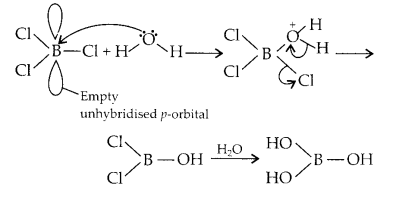
But, when \(\mathrm{CCl}_4\) is mixed with water, no reaction takes place because carbon neither has any unhybridised, empty \(p\)-orbital where it can accommodate electrons from water nor it has empty \(d\)-orbital.
\(\mathrm{CCl}_4+\mathrm{H}_2 \mathrm{O} \rightarrow\) No reaction
Q5. Is boric acid a protic actd ? Explain.
Answer: Boric acid is a Lewis acid, it is not a protonic acid. Boric acid \(-\mathrm{H}_3 \mathrm{BO}_3\) or \(\mathrm{B}(\mathrm{OH})_3\), is not a protic acid (which are acids that donate protons). But an aqueous solution of boric acid is found to be weakly acidic in nature. This acidic character arises due to the Lewis acid character of boric acid which abstracts a hydroxyl ion from water and leaves free \(\mathrm{H}^{+}\)ions which make the solution acidic.
\(\text { Boric acid accepts electrons from hydroxyl ion of } \mathrm{H}_2 \mathrm{O} \text { molecule. }\)
\(
\mathrm{B}(\mathrm{OH})_3+2 \mathrm{HOH} \longrightarrow \left[\mathrm{B}(\mathrm{OH})_4\right]^{-}+\mathrm{H}_3 \mathrm{O}^{+}
\)
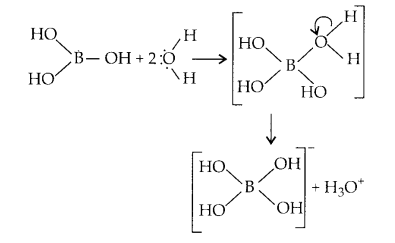
Q6. Explain what happens when boric acid is heated.
Answer: On heating orthoboric acid above 370 K , it forms metaboric acid, \(\mathrm{HBO}_2\) which on further heating yields boric oxide, \(\mathrm{B}_2 \mathrm{O}_3\).
\(
\mathrm{H}_3 \mathrm{BO}_3 \xrightarrow{\Delta} \mathrm{HBO}_2 \xrightarrow{\Delta} \mathrm{~B}_2 \mathrm{O}_3
\)
Q7. Describe the shapes of \(\mathrm{BF}_3\) and \(\mathrm{BH}_4^{-}\). Assign the hybridisation of boron in these species.
Answer: In \(\mathrm{BF}_3\), boron is \(\mathrm{SP}^2\) hybridized.
\(\therefore\) shape of \(\mathrm{BF}_3=\) planar.
In \(\left[\mathrm{BH}_4\right]^{-}\), boron is sp3 hybridized, thus the shape is tetrahedral.

Q8. Write reactions to justify amphoteric nature of aluminium.
Answer: Amphoteric substances are those that can react with both acids and bases. Aluminium reacts with \(\mathrm{HCl}\) to liberate \(\mathrm{H}_2\) gas as :
\(
2 \mathrm{Al}_{(s)}+2 \mathrm{NaOH}_{(a q)}+6 \mathrm{H}_2 \mathrm{O}_{(l)} \longrightarrow \underbrace{2 \mathrm{Na}^{+}\left[\mathrm{Al}(\mathrm{OH})_4\right]_{(a q)}^{-}}_{\text {Sodium tetrahydroxoaluminate (11I) }} +3 \mathrm{H}_2 \uparrow
\)
Q9. What are electron deficient compounds ? Are \(\mathrm{BCl}_3\) and \(\mathrm{SiCl}_4\) electron deficient species ? Explain.
Answer: Electron deficient compounds are those where the central atom has less than \(8 e^{-}\mathrm{s}\) in its outermost shell. Out of \(\mathrm{BCl}_3\) and \(\mathrm{SiCl}_4\), the former is an electron deficient compound since it has only 6 electrons in the outermost shell. \(\mathrm{SiCl}_4\) is not an electron deficient compound. However, it can accept electrons by expanding its octet due to presence of empty \(d\)-orbitals. Thus, it may form species like \(\mathrm{SiF}_6^{2-}\).
Q10. Write the resonance structures of \(\mathrm{CO}_3^{2-}\) and \(\mathrm{HCO}_3^{-}\).
Answer: The resonance structures of \(\mathrm{CO}_3^{2-}\) and \(\mathrm{HCO}_3^{-}\)are :
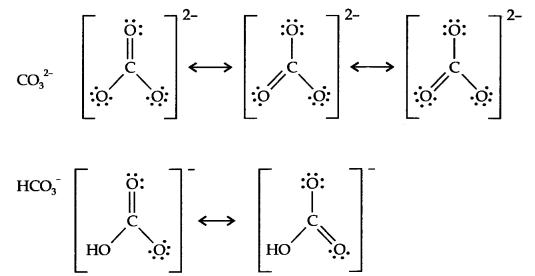
Q11. What is the state of hybridisation of carbon in (a) \(\mathrm{CO}_3^{2-}\) (b) diamond (c) graphite?
Answer: (a) \(\mathrm{C}\) in \(\mathrm{CO}_3^{2-}\) ion is \(s p^2\) hybridised This can be explained as :

(b) Diamond : \(\mathrm{C}\) is \(s p^3\) hybridised in diamond. This gives it a tetrahedral structure rendering it hard.
(c) Graphite: \(\mathrm{C}\) is \(s p^2\) hybridised in graphite. It forms 3 bonds with 3 other carbon atoms in the same plane while the fourth covalency is satisfied by \(\pi\)-bonding. These \(\pi\)-electrons are delocalised over the whole sheet.
Q12. Explain the difference in properties of diamond and graphite on the basis of their structures.
Answer:
\(\begin{array}{|l|l|l|}
\hline \text { Criterion } & \text { Diamond } & \text { Graphite } \\
\hline \text { Hybridisation } & \mathrm{Sp}^3 & \mathrm{Sp}^2 \\
\hline \text { Structure of C } & \begin{array}{c}
\text { Tetrahedral carbon which gives } \\
\text { rise to a 3-dimensional structure. }
\end{array} & \begin{array}{c}
\text { Planar trigonal which gives rise } \\
\text { to a 2-dimensional sheet like } \\
\text { structure of carbon. }
\end{array} \\
\hline \mathrm{C}-\mathrm{C} & 154 \mathrm{pm} & 141.5 \mathrm{pm} \\
\hline \text { Hardness } & \begin{array}{c}
\text { Due to 3-D structure, diamond is } \\
\text { the hardest natural element on } \\
\text { the earth. }
\end{array} & \begin{array}{c}
\text { It made up of 2-D sheets of } \\
\text { carbon which slip over each } \\
\text { other. This gives graphite a } \\
\text { slippery surface. }
\end{array} \\
\hline \text { Electrical Conductivity } & \text { Diamond is an insulator } & \begin{array}{c}
\text { Graphite is a good conductor of } \\
\text { electricity due to presence of } \\
\text { delocalized } \pi \text {-electrons. }
\end{array} \\
\hline
\end{array}
\)
Q13. Rationalise the given statements and give chemical reactions:
- Lead(II) chloride reacts with \(\mathrm{Cl}_2\) to give \(\mathrm{PbCl}_4\).
- Lead(IV) chloride is highly unstable towards heat.
- Lead is known not to form an iodide, \(\mathrm{PbI}_4\).
Answer:(i) \(\mathrm{PbCl}_2+\mathrm{Cl}_2 \rightarrow \mathrm{PbCl}_4\)
Lead is more stable in +2 oxidation state than in +4 state due to inert pair effect. Thus, the reaction is not feasible.
(ii) \(\mathrm{PbCl}_4 \xrightarrow{\Delta} \mathrm{PbCl}_2+\mathrm{Cl}_2\)
Pb is more stable in its +2 oxidation state due to inert pair effect. As a result, when subjected to heat, Pb (IV) goes to Pb (II) state.
(iii) \(\mathrm{Pb}^{4+} +2\mathrm{I}^{-} \longrightarrow \mathrm{Pb}^{2+}+\mathrm{I}_2\)
\(\mathrm{I}^{-}\)is a good reducing agent and therefore, reduces Pb (IV) to Pb (II) easily: That is why, \(\mathrm{PbI}_4\) does not exist.
Q14. Suggest reasons why the \(\mathrm{B}-\mathrm{F}\) bond lengths in \(\mathrm{BF}_3(130 \mathrm{pm})\) and \(\mathrm{BF}_4^{-}\) (143 pm) differ.
Answer: The bond length in anv compound is dependent on the hybridisation of the central atom. Boron in \(\mathrm{BF}_3\) is \(\mathrm{sp}^2\) hybridised which means that the s-character is \(33 \%\) and therefore, the bond length is shorter. Also due to similar size of both atoms and vacant \(p\)-orbital of \(\mathrm{B}\) , a pr-pr back bonding from \(\mathrm{F}\) to \(\mathrm{B}\) occurs causes partial double bond character. This further decreases the bond length of \(\mathrm{B-F}\). In \(B F_4^{-}\), the hybridisation of \(\mathrm{B}\) is \(\mathrm{sp}^3\) which means that the s -character is \(25 \%\) and therefore, a longer bond length.
Q15. If \(\mathrm{B}-\mathrm{Cl}\) bond has a dipole moment, explain why \(\mathrm{BCl}_3\) molecule has zero dipole moment.
Answer: \(\mathrm{B}-\mathrm{Cl}\) bond has dipole moment because of polarity. In \(\mathrm{BCl}_3\) since the molecule is symmetrical (planar). Thus the polarities cancel out.
Explanation: The dipole moment of any molecule is the vector sum total of each of the dipole moments. In \(\mathrm{BCl}_3\), molecule, although the \(\mathrm{B-Cl}\) bonds individually are polar, the resultant dipole moment becomes zero.
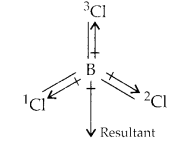
Q16. Explain why is there a phenomenal decrease in ionization enthalpy from carbon to silicon?
Answer: Because there is increase in atomic size on moving from carbon to silicon, the screening effect increases. Thus the force of attraction of nucleus for the valence electron decreases as compared to carbon. Thus the ionization enthapy decreases from carbon to silicon.
Q17. How would you explain the lower atomic radius of \(\mathrm{Ga}\) as compared to \(\mathrm{Al}\) ?
Answer: Due to poor shielding effect of \(d\)-electrons in \(\mathrm{Ga}\), the electrons in gallium experience great force of attraction by nucleus as compared to \(\mathrm{Al}\).
Q18. What are allotropes? Sketch the structure of two allotropes of carbon namely diamond and graphite. What is the impact of structure on physical properties of two allotropes?
Answer: Allotropes: Allotropes are the different forms of an element which are having same chemical properties but different physical properties due to their structures. The property due to which an element exists in two or more forms which differ in their physical and some of the chemical properties is known as allotropy and the various forms are called allotropes or allotropic modifications. Carbon exists in two allotropic forms crystalline and amorphous. The crystalline forms are diamond and graphite.
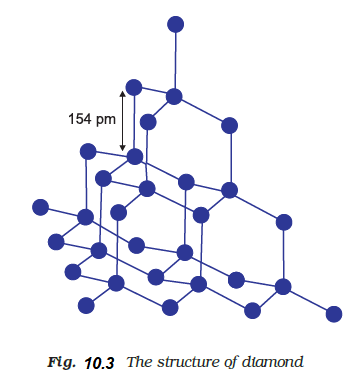
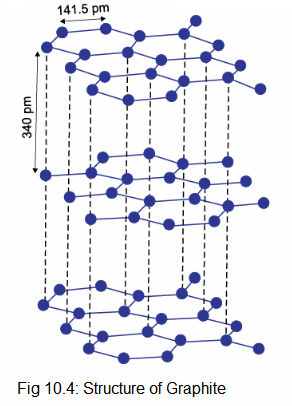
In diamond, carbon is \({SP}^3\)-hybridized. Since, diamond is three dimensional network solid, it is hardest substance with high density whereas graphite has a layered structure. The various layers are formed by van der Waals forces of attraction that’s why graphite is soft and slippery. Diamond due to extended covalent bonding is the hardest natural substance on the earth. with \(\mathrm{Al}_2\left(\mathrm{SO}_4\right)_3\) which is soluble in Water
Q19. (a) Classify following oxides as neutral, acidic, basic or amphoteric:
\(
\mathrm{CO}, \mathrm{~B}_2 \mathrm{O}_3, \mathrm{SiO}_2, \mathrm{CO}_2, \mathrm{Al}_2 \mathrm{O}_3, \mathrm{PbO}_2, \mathrm{Tl}_2 \mathrm{O}_3
\)
(b) Write suitable chemical equations to show their nature.
Answer: (a) Neutral oxides : \(\mathrm{CO}\)
Acidic oxides : \(\mathrm{B}_2 \mathrm{O}_3, \mathrm{SiO}_2, \mathrm{CO}_2\)
Basic oxides : \(\mathrm{Tl}_2 \mathrm{O}_3\)
Amphoteric oxides: \(\mathrm{Al}_2 \mathrm{O}_3, \mathrm{PbO}_2\).
(b) (i) \(\mathrm{CO}\) Neutral to litmus [Neutral]
(ii) \(\mathrm{B}_2 \mathrm{O}_3\) reacts with basic (metallic) oxides forming meta-borates.
\(
\mathrm{B}_2 \mathrm{O}_3+\mathrm{CuO} \rightarrow \mathrm{Cu}\left(\mathrm{BO}_2\right)_2 \quad \text { [Acidic] }
\)
(iii) \(\mathrm{SiO}_2+2 \mathrm{NaOH} \longrightarrow \mathrm{Na}_2 \mathrm{SiO}_3+\mathrm{H}_2 \mathrm{O}\) [Acidic]
(iv) \(\mathrm{CO}_2+2 \mathrm{NaOH} \longrightarrow \mathrm{Na}_2 \mathrm{CO}_3+\mathrm{H}_2 \mathrm{O}\) [Acidic]
(v) \(\mathrm{Tl}_2 \mathrm{O}_3+3 \mathrm{H}_2 \mathrm{SO}_4 \rightarrow \mathrm{Tl}_2\left(\mathrm{SO}_4\right)_3+3 \mathrm{H}_2 \mathrm{O}\) [Basic]
(vi)
\(
\left.\begin{array}{l}
\mathrm{Al}_2 \mathrm{O}_3+6 \mathrm{HCl} \longrightarrow 2 \mathrm{AlCl}_3+3 \mathrm{H}_2 \mathrm{O} \\
\mathrm{Al}_2 \mathrm{O}_3+2 \mathrm{NaOH} \longrightarrow 2 \mathrm{NaAlO}_2+\mathrm{H}_2 \mathrm{O}
\end{array}\right\}[\text { Amphoteric }]
\)
(vii)
\(
\left.\begin{array}{l}
\mathrm{PbO}_2+2 \mathrm{NaOH} \longrightarrow \mathrm{Na}_2 \mathrm{PbO}_3+\mathrm{H}_2 \mathrm{O} \\
\mathrm{PbO}_2+4 \mathrm{HCl} \longrightarrow \mathrm{PbCl}_2+\mathrm{Cl}_2+2 \mathrm{H}_2 \mathrm{O}
\end{array}\right\} \text { [Amphoteric] }
\)
Q20. In some of the reactions thallium resembles aluminium, whereas in others it resembles with group I metals. Support this statement by giving some evidences.
Answer: Aluminium (\(\mathrm{Al}\)) generally exhibits +3 oxidation state in its compounds. Thallium \((\mathrm{Tl})\), the last member of the group 13 , shows oxidation state of +3 i.e., \(\mathrm{Tl}_2 \mathrm{O}_3\). Like \(\mathrm{Al}, \mathrm{Tl}\) form octahedral complexes \(i. e.,\left[\mathrm{TlF}_6\right]^{3-}\). \(\mathrm{Tl}\) like alkali metals shows oxidation state of +1 (due to inert pair effect). \(\mathrm{TlOH}\) like \(\mathrm{NaOH}\) is soluble in water and the solution is strongly alkaline. Like alkali metals, \(\mathrm{Tl}_2 \mathrm{SO}_4\) forms a double sulphate with \(\mathrm{Al}_2\left(\mathrm{SO}_4\right)_3\) which is soluble in water. \((\mathrm{Tl})\) shows both the oxidation state +1 and +3 due to inert pair effect. \((\mathrm{Tl})\) forms basic oxide like group I elements. \(\mathrm{TlO}_2\) is strongly basic.
Q21. When metal \(X\) is treated with sodium hydroxide, a white precipitate \((\mathrm{A})\) is obtained, which is soluble in excess of \(\mathrm{NaOH}\) to give soluble complex (B). Compound (A) is soluble in dilute \(\mathrm{HCl}\) to form compound (C). The compound (A) when heated strongly gives (D), which is used to extract metal. Identify (X), (A), (B), (C) and (D). Write suitable equations to support their identities.
Answer: The given data suggests that the metal \(X\) is aluminium.
\(
\underset{(X)}{2 \mathrm{Al}}+2 \mathrm{NaOH}+2 \mathrm{H}_2 \mathrm{O} \longrightarrow 2 \mathrm{NaAlO}_2+3 \mathrm{H}_2
\)
\(
\mathrm{NaAlO}_2+2 \mathrm{H}_2 \mathrm{O} \rightarrow \underbrace{\mathrm{Al}(\mathrm{OH})_3}_{\begin{array}{c}
\text { White gelatinous } \\
\text { ppt. }(A)
\end{array}}
\)
\(
\xrightarrow[\mathrm{NaOH}]{\text { Excess }} \underbrace{\mathrm{Na}\left[\mathrm{Al}(\mathrm{OH})_4\right]}_{\begin{array}{c}
\text { Sodium tetrahydroxo } \\
\text { aluminate (III) (soluble, } B \text { ) }
\end{array}}
\)
\(
\underset{(A)}{\mathrm{Al}(\mathrm{OH})_3}+3 \mathrm{HCl} \longrightarrow \underset{\text { (C) }}{\mathrm{AlCl}_3}+3 \mathrm{H}_2 \mathrm{O}
\)
\(
\underset{(A)}{2 \mathrm{Al}(\mathrm{OH})_3}\xrightarrow{\Delta} \underset{\text { (D) }}{\mathrm{Al}_2 \mathrm{O}_3}+3 \mathrm{H}_2 \mathrm{O}
\)
Q22. What do you understand by (a) inert pair effect (b) allotropy and (c) catenation?
Answer: (a) Inert pair effect: The pair of electron in the valence shell does not take part in bond formation is called inert pair effect.
(b) Allotropy: It is the property of the element by which an element can exist in two or more forms which have same chemical properties but different physical properties due to their structures.
(c) Catenation: The property to form chains or rings not only with single bonds but also with multiple bonds with itself is called catenation.
For example, carbon forms chains with ( \(\mathrm{C}-\mathrm{C}\) ) single bonds and also with multiple bonds ( \(\mathrm{C}=\mathrm{C}\) or \(\mathrm{C}=\mathrm{C}\) ).
Q23. A certain salt \(\mathrm{X}\) , gives the following results.
(i) Its aqueous solution is alkaline to litmus.
(ii) It swells up to a glassy material \(\mathrm{Y}\) on strong heating.
(iii) When conc. \(\mathrm{H}_2 \mathrm{SO}_4\) is added to a hot solution of \(\mathrm{X}\) , white crystal of an acid \(\mathrm{Z}\) separates out.
Write equations for all the above reactions and identify \(\mathrm{X}, \mathrm{Y}\) and \(\mathrm{Z}\).
Answer: The data suggests that the salt ‘ \(X\) ‘ is Borax \(\left(\mathrm{Na}_2 \mathrm{~B}_4 \mathrm{O}_7 \cdot 10 \mathrm{H}_2 \mathrm{O}\right)\).
(i) The aqueous solution of borax is basic in nature due to hydrolysis and turns red litmus blue.
\(
\underset{(X)}{\mathrm{Na}_2 \mathrm{~B}_4 \mathrm{O}_7}+7 \mathrm{H}_2 \mathrm{O} \longrightarrow \underset{\text { (Weak acid) }}{4 \mathrm{H}_3 \mathrm{BO}_3}+\underset{\text { (Strong base) }}{2 \mathrm{NaOH}}
\)
(ii) Borax swells in size upon strong heating and loses molecules of water of crystallisation to form solid \((Y)\).
\(
\mathrm{Na}_2 \mathrm{~B}_4 \mathrm{O}_7 \cdot 10 \mathrm{H}_2 \mathrm{O} \xrightarrow[-10 \mathrm{H}_2 \mathrm{O}]{\text { heat }} \mathrm{Na}_2 \mathrm{~B}_4 \mathrm{O}_7 \xrightarrow{\text { strong heating }}\underbrace{2 \mathrm{NaBO}_2+\mathrm{B}_2 \mathrm{O}_3}_{\text {Glassy }(Y)}
\)
(iii) Upon reacting with conc. \(\mathrm{H}_2 \mathrm{SO}_4\), borax forms boric acid \(\left(\mathrm{H}_3 \mathrm{BO}_3\right)\). When crystallised from the solution, it is in the form of white crystals \((Z)\).
\(
\mathrm{Na}_2 \mathrm{~B}_4 \mathrm{O}_7+\mathrm{H}_2 \mathrm{SO}_4+5 \mathrm{H}_2 \mathrm{O} \longrightarrow \mathrm{Na}_2 \mathrm{SO}_4+4 \mathrm{H}_3 \mathrm{BO}_3
\)
Q24. Write balanced equations for:
(i) \(\mathrm{BF}_3+\mathrm{LiH} \rightarrow\)
(ii) \(\mathrm{B}_2 \mathrm{H}_6+\mathrm{H}_2 \mathrm{O} \rightarrow\)
(iil) \(\mathrm{NaH}+\mathrm{B}_2 \mathrm{H}_6 \rightarrow\)
(iv) \(\mathrm{H}_3 \mathrm{BO}_3 \xrightarrow{\Delta}\)
(v) \(\mathrm{Al}+\mathrm{NaOH} \rightarrow\)
(vi) \(\mathrm{B}_2 \mathrm{H}_6+\mathrm{NH}_3 \rightarrow\)
Answer: (i) \(2 \mathrm{BF}_3+6 \mathrm{LiH} \longrightarrow \underset{\substack{\text { Diborane }}}{\mathrm{B}_2 \mathrm{H}_6} +6 \mathrm{LiF}\)
(ii) \(\underset{\substack{\text { Diborane }}}{\mathrm{B}_2 \mathrm{H}_6}+6 \mathrm{H}_2 \mathrm{O} \longrightarrow \underset{\substack{\text { Orthoboric acid }}}{2 \mathrm{H}_3 \mathrm{BO}_3}+6 \mathrm{H}_2\)
(iii) \(2 \mathrm{NaH}+\mathrm{B}_2 \mathrm{H}_6 \longrightarrow \underset{\begin{array}{c}\text { Sod. borohydride }\end{array}}{2 \mathrm{Na}^{+}\left[\mathrm{BH}_4\right]^{-}}\)
(iv) \(\underset{\text { Orthoboric acid }}{\mathrm{H}_3 \mathrm{BO}_3} \xrightarrow{\Delta} \underset{\text { Metaboric acte }}{\mathrm{HBO}_2}+\mathrm{H}_2 \mathrm{O}\)
\(\underset{\text { Metaboric acid }}{4 \mathrm{HBO}_2} \xrightarrow[-\mathrm{H}_2 \mathrm{O}]{\Delta} \underset{\text { Tetraboric acid }}{\mathrm{H}_2 \mathrm{~B}_4 \mathrm{O}_7} \longrightarrow \underset{\text { Boron trioxide }}{2 \mathrm{~B}_2 \mathrm{O}_3}+\mathrm{H}_2 \mathrm{O}\)
(v)
\(2 \mathrm{Al}+2 \mathrm{NaOH}+6 \mathrm{H}_2 \mathrm{O} \longrightarrow \begin{gathered}
2 \mathrm{Na}^{+}\left[\mathrm{Al}(\mathrm{OH})_4\right]^{-}+3 \mathrm{H}_2 \\
\text { Sod. tetrahydroxoaluminate (III) }
\end{gathered}
\)
(vi)
\(
\mathrm{B}_2 \mathrm{H}_6+2 \mathrm{NH}_3 \longrightarrow \quad \begin{gathered}
2 \mathrm{BH}_3 \cdot \mathrm{NH}_3 \\
\text { Borane-ammonia complex }
\end{gathered}
\)
Q25. Give one method for industrial preparation and one for laboratory preparation of CO and \(\mathrm{CO}_2\) each.
Answer: Preparation of \(\mathrm{CO}\) :
Lab method : Pure \(\mathrm{CO}\) is prepared by dehydration of formic acid or oxalic acid with concentrated \(\mathrm{H}_2 \mathrm{SO}_4\) at 373 K.
\(
\mathrm{HCOOH} \xrightarrow[\text { conc. } \mathrm{H}_2 \mathrm{SO}_4]{373 \mathrm{k}} \mathrm{CO}+\mathrm{H}_2 \mathrm{O}
\)
Industrial method : \(\mathrm{CO}\) is prepared by the passage of steam over hot coke. The mixture of \(\mathrm{CO}\) and \(\mathrm{H}_2\) thus, produced is known as water gas or synthesis gas.
\(
\mathrm{C}_{(s)}+\mathrm{H}_2 \mathrm{O}_{(\mathrm{s})} \xrightarrow{473-1273 \mathrm{~K}}\underbrace{\mathrm{CO}_{(g)}+\mathrm{H}_{2(g)}}_{\text {Water gas }}
\)
When air is used instead of steam, a mixture of \(\mathrm{CO}\) and \(\mathrm{N}_2\) is produced, which is called producer gas.
\(
2 \mathrm{C}_{(s)}+\mathrm{O}_{2(g)}+\mathrm{N}_{2(g)} \xrightarrow{1273 \mathrm{~K}} \underbrace{2 \mathrm{CO}_{(g)}+\mathrm{N}_{2(g)}}_{\text {Producer gas }}
\)
Preparation of \(\mathrm{CO}_2\) :
Lab method: In the laboratory it is conveniently prepared by the action of dilute \(\mathrm{HCl}\) on calcium carbonate.
\(
\mathrm{CaCO}_{3(s)}+2 \mathrm{HCl}_{(a q)} \longrightarrow \mathrm{CaCl}_{2(a q)}+\mathrm{CO}_{2(g)}+\mathrm{H}_2 \mathrm{O}_{(l)}
\)
Industrial method: When lime is manufactured by the calcination of limestone \(\left(\mathrm{CaCO}_3\right)\), carbon dioxide is obtained as a by product.
\(
\mathrm{CaCO}_3 \longrightarrow \mathrm{CaO}+\mathrm{CO}_2
\)
Q26. An aqueous solution of borax is
(a) neutral
(b) amphoteric
(c) basic
(d) acidic
Answer: (c): Borax dissolves in water to give an alkaline solution. Thus it is of basic nature due to hydrolysis and turns red litmus blue.
\(
\mathrm{Na}_2 \mathrm{~B}_4 \mathrm{O}_7+7 \mathrm{H}_2 \mathrm{O} \longrightarrow \underset{\text { weak acid }}{4 \mathrm{H}_3 \mathrm{BO}_3}+\underset{\text { strong base }}{2 \mathrm{NaOH}}
\)
Q27. Boric acid is polymeric due to
(a) its acidic nature
(b) the presence of hydrogen bonds
(c) its monobasic nature
(d) its geometry
Answer: Boric acid is polymeric due to the presence of H-bonds.
Q28. The type of hybridisation of boron in diborane is
(a) \(s p\)
(b) \(s p^2\)
(c) \(s p^3\)
(d) \(d s p^2\)
Answer: In \(\mathrm{B}_2 \mathrm{H}_6, \mathrm{~B}\) is \(\mathrm{sp}^3\)-hybridized. Therefore, option (c) is correct.
Q29. Thermodynamically the most stable form of carbon is
(a) diamond
(b) graphite
(c) fullerenes
(d) coal
Answer: Thermodynamically the most stable form of carbon is graphite, i.e., option (b) is correct. [ Graphite is thermodynamically more stable than diamond and its free energy of formation is 1.9 kJ \(\mathrm{mol}^{-1}\) less than diamond.]
Q30. Elements of group 14
(a) exhibit oxidation state of +4 only
(b) exhibit oxidation state of +2 and +4
(c) form \(\mathrm{M}^{2-}\) and \(\mathrm{M}^{4+}\) ions
(d) form \(\mathrm{M}^{2+}\) and \(\mathrm{M}^{4+}\) tons
Answer: (b, d): The group 14 elements have four electrons in outermost shell. The common oxidation states exhibited by these elements are +4 and +2 .
Elements like \(\mathrm{Sn}\) and \(\mathrm{Pb}\) are metallic thus, form \(\mathrm{M}^{2+}\) and \(\mathrm{M}^{4+}\) ions.
Exemplar Section
Short Answer Type
Q1. Draw the structures of \(\mathrm{BCl}_3 \cdot \mathrm{NH}_3\) and \(\mathrm{AlCl}_3\) (dimer).
Answer: In \(\mathrm{BCl}_3\), the central \(\mathrm{B}\) atom has six electrons in the valence shell. It is, therefore, an electron deficient molecule and needs two more electrons to ‘ complete its octet. In other words, \(\mathrm{BCl}_3\) acts as a Lewis acid. \(\mathrm{NH}_3\), on the other hand, has a lone pair of electrons which it can donate easily. Therefore, \(\mathrm{NH}_3\) acts as a Lewis base. The Lewis acid \(\left(\mathrm{BC1}_3\right)\) and the Lewis base \(\left(\mathrm{NH}_3\right)\) combine together to form an adduct as shown below:
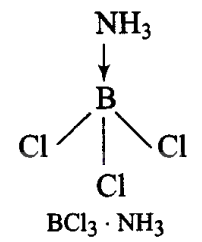
In \(\mathrm{AlCl}_3, \mathrm{~Al}\) has six electrons in the valence shell. Therefore, it is an electron deficient molecule and needs two more electrons to complete its octet.
Chlorine, on the other hand, has three lone pairs of electrons. Therefore, to complete its octet, the central \(\mathrm{Al}\) atom of one molecule accepts a lone pair of electrons from \(\mathrm{Cl}\) atom of the other molecule forming a dimeric structure as shown below.
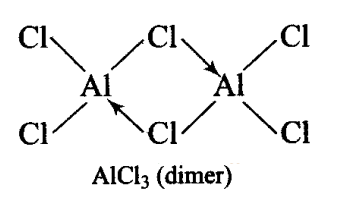
Q2. Explain the nature of boric acid as a Lewis acid in water.
Answer: Boric acid is a weak monobasic acid and acts as a Lewis acid by accepting electrons from a hydroxyl ion.
\(
\mathrm{B}(\mathrm{OH})_3+2 \mathrm{H}_2 \mathrm{O} \rightarrow\left[\mathrm{~B}(\mathrm{OH})_4\right]^{-}+\mathrm{H}_3 \mathrm{O}^{+}
\)
Q3. Draw the structure of boric acid showing hydrogen bonding. Which species is present in water? What is the hybridisation of boron in this species?
Answer: Orthoboric acid \(\mathrm{H}_3 \mathrm{BO}_3\), in solid state possesses a layer structure made up of \(\mathrm{B}(\mathrm{OH})_3\) units forming hexagonal rings of H -bonding as given below
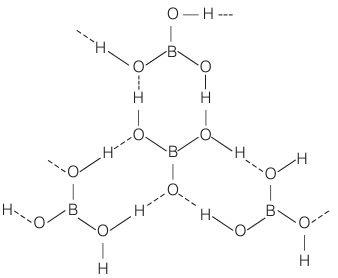
Each H -atom acts as a bridge between two oxygen atoms of different \(\mathrm{BO}_3^{3-}\) units.
Boric acid when dissolved in water, acts as Lewis acid forming \(\mathrm{B}(\mathrm{OH})_4^{-}\)
\(
\mathrm{H}_3 \mathrm{BO}_3+\mathrm{H}_2 \mathrm{O} \longrightarrow \mathrm{~B}(\mathrm{OH})_4^{-}+\mathrm{H}^{+}
\)
The hybridisation of boron in \(\mathrm{B}(\mathrm{OH})_4^{-}\)is \(s p^3\).
Q4. Explain why the following compounds behave as Lewis acids?
(i) \(\mathrm{BCl}_3\)
(ii) \(\mathrm{AlCl}_3\)
Answer: (i) \(\mathrm{BCl}_3\) : Boron has 6 electrons in its outermost orbital and has a vacant \(p\) orbital. Thus, it is an electron deficient compound. Hence, it acts as Lewis acid and accepts a lone pair of electrons.
(ii) \(\mathrm{AlCl}_3\) is also an electron deficient compound and acts as Lewis acid. It generally forms a dimer to achieve stability.
Q5. Give reasons for the following:
(i) \(\mathrm{CCl}_4\) is immiscible in water, whereas \(\mathrm{SiCl}_4\) is easily hydrolysed.
(ii) Carbon has a strong tendency for catenation compared to silicon.
Answer: (i) \(\mathrm{CCl}_4\) is a covalent compound while \(\mathrm{H}_2 \mathrm{O}\) is a polar compound. Therefore, it is insoluble in water. Alternatively, \(\mathrm{CCl}_4\) is insoluble in water because carbon does not have \(d\)-orbitals to accommodate the electrons donated by oxygen atom of water molecules. As a result, there is no interaction between \(\mathrm{CCl}_4\) and water molecules and hence \(\mathrm{CCl}_4\) is insoluble in water. On the other hand, \(\mathrm{SiCl}_4\) has \(d\)-orbitals to accommodate the lone pair of electrons donated by oxygen atom of water molecules. As a result, there is a strong interaction between \(\mathrm{SiCl}_4\) and water molecules. Consequently, \(\mathrm{SiCl}_4\) undergoes hydrolysis by water to form silicic acid.
(ii) The bond dissociation energy decreases rapidly as the atomic size increases. Since the atomic size of carbon is much smaller ( 77 pm ) as compared to that of silicon (118 pm), therefore, carbon-carbon bond dissociation energy is much higher ( \(348 \mathrm{~kJ} \mathrm{~mol}^{-1}\) ) than that of silicon-silicon bond ( \(297 \mathrm{~kJ} \mathrm{~mol}^{-1}\) ). Hence, because \(\mathrm{C-C}\) bonds are much stronger as compared to \(\mathrm{Si-Si}\) bonds, carbon has a much higher tendency for catenation than silicon [Down the group, the size increases and electronegativity decreases and thereby, tendency to show catenation decreases. Thus, carbon has a strong tendency for catenation as compared to silicon.]
Q6. Explain the following :
(i) \(\mathrm{CO}_2\) is a gas whereas \(\mathrm{SiO}_2\) is a solid.
(ii) Silicon forms \(\mathrm{SiF}_6{ }^{2-}\) ion whereas corresponding fluoro compound of carbon is not known.
Answer: (i) Because of its small size and good \(\pi\)-overlap with other small atoms, carbon forms strong double bonds with two oxygen atoms to give discrete \(\mathrm{CO}_2\) molecules. Silicon atom, on account of large size, does not have good \(\pi\)-overlap with other atoms. It uses its four valence electrons to form four single bonds directed towards the four apices of a tetrahedron ( \(\mathrm{sp}^3\) hybridisation). Each oxygen is linked with two silicon atoms, i.e., a giant three dimensional structure comes into existence which is very stable. Thus, \(\mathrm{CO}_2\) is a gas and \(\mathrm{SiO}_2\) is a solid.
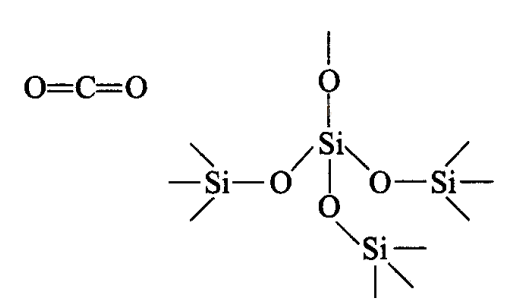
(ii) Silicon has 3\(\mathrm{d}\)-orbitals in the valence shell and thus expands its octet giving \(\mathrm{sp}^3 \mathrm{d}^2\) hybridisation while \(\mathrm{d}\) orbitals are not present in the valence shell of carbon. It can undergo \(\mathrm{sp}^3\)-hybridisation only. Thus, carbon is unable to form \(\mathrm{CF}_6{ }^{2-}\) anion.
Q7. Explain the following :
(i) Gallium has higher ionisation enthalpy than aluminium.
(ii) Boron does not exist as \(\mathrm{B}^{3+}\) ion.
(iii) Aluminium forms \(\left[\mathrm{AlF}_6\right]^{3-}\) ion but boron does not form \(\left[\mathrm{BF}_6\right]^{3-}\) ion.
(iv) \(\mathrm{PbX}_2\) is more stable than \(\mathrm{PbX}_4\).
(v) \(\mathrm{Pb}^{4+}\) acts as an oxidising agent but \(\mathrm{Sn}^{2+}\) acts as a reducing agent.
(vi) Electron gain enthalpy of chlorine is more negative as compared to fluorine.
(vii) \(\mathrm{Tl}\left(\mathrm{NO}_3\right)_3\) acts as an oxidising agent.
(viii) Carbon shows catenation property but lead does not.
(ix) \(\mathrm{BF}_3\) does not hydrolyse.
(x) Why does the element silicon, not form a graphite like structure whereas carbon does.
Answer: (i) In gallium, due to poor shielding of valence electrons by the intervening \(3 d\) electrons. The nuclear charge becomes effective, thus, atomic radius decreases and hence, the ionisation enthalpy of gallium is higher than that of aluminium.
(ii) Due to small size of boron, the sum of its first three ionisation enthalpies is very high. This prevent it to form +3 ions and force it to form only covalent compound. That’s why boron does not exist as \(\mathrm{B}^{3+}\) ion.
(iii) Aluminium forms \(\left[\mathrm{AlF}_6\right]^{3-}\) ion because of the presence of vacant \(d\)-orbitals so it can expand its coordination number from 4 to 6 . In this complex, Al undergoes \(s p^3 d^2\) hybridisation.
On the other hand, boron does not form \(\left[\mathrm{BF}_6\right]^{3-}\) ion, because of the unavailability of \(d\)-orbitals as it cannot expand its coordination number beyond four. Hence, it can form \(\left[\mathrm{BF}_4\right]^{-}\)ion ( \(s p^3\) hybridisation).
(iv) Due to inert pair effect, \(\mathrm{Pb}\) in +2 oxidation state is more stable than in +4 oxidation state hence \(\mathrm{PbX}_2\) is more stable than \(\mathrm{PbX}{ }_4\).
(v) Due to inert pair effect, tendency to form +2 ions increases down the group, hence \(\mathrm{Pb}^{2+}\) is more stable than \(\mathrm{Pb}^{4+}\). That’s why \(\mathrm{Pb}^{4+}\) acts as an oxidising agent while \(\mathrm{Sn}^{2+}\) is less stable than \(\mathrm{Sn}^{4+}\) and hence \(\mathrm{Sn}^{2+}\) acts as a reducing agent.
\(
\underset{\text { Reducing agent }}{\mathrm{Sn}^{2+}} \longrightarrow \mathrm{Sn}^{4+}+2 \mathrm{e}^{-}
\)
\(
\underset{\text { Oxidising agent }}{\mathrm{Pb}^{4+}}+2 \mathrm{e}^{-} \longrightarrow \mathrm{Pb}^{2+}
\)
(vi) Electron gain enthalpy of \(\mathrm{Cl}\) is more negative than electron gain enthalpy of fluorine because when an electron is added to \(F\), the added electron goes to the smaller \(n=2\) quantum level and suffers significant repulsion from other electrons present in this level. For \(n=3\) quantum level (in \(\mathrm{Cl}\) ) the added electron occupies a larger region of space and the electron-electron repulsion is much less.
(vii) Due to inert pair effect, \(\mathrm{Tl}\) in +1 oxidation state is more stable than that of +3 oxidation state. Therefore, \(\mathrm{Tl}\left(\mathrm{NO}_3\right)_3\) acts as an oxidising agent.
(viii) Property of catenation depends upon the atomic size of the element. Down the group, size increases and electronegativity decreases, thus the tendency to show catenation decreases. As the size of C is much smaller than Pb , therefore, carbon show property of catenation but lead does not show catenation.
(ix) Unlike other boron halides, \(\mathrm{BF}_3\) does not hydrolyse completely. However, it form boric acid and fluoroboric acid. This is because the HF first formed reacts with \(\mathrm{H}_3 \mathrm{BO}_3\).
(x) In graphite, \(\mathrm{C}\) is \(s p^2\) hybridised. Carbon due to its smallest size and highest electronegativity among group 14 elements has strong tendency to form \(p \pi-p \pi\) multiple bonds while silicon due to its larger size and less electronegativity has poor ability to form \(p \pi-p \pi\) multiple bonds. That’s why the element silicon does not form a graphite like structure.
Q8. Identify the compounds \(\mathrm{A}, \mathrm{X}\) and \(\mathrm{Z}\) in the following reactions :
(i) \(\mathrm{A}+2 \mathrm{HCl}+5 \mathrm{H}_2 \mathrm{O} \longrightarrow 2 \mathrm{NaCl}+\mathrm{X}\)
(ii) \(\mathrm{X} \xrightarrow[370 \mathrm{~K}]{\Delta} \mathrm{HBO}_2 \xrightarrow[>370 \mathrm{~K}]{\Delta} \mathrm{Z}\)
Answer:
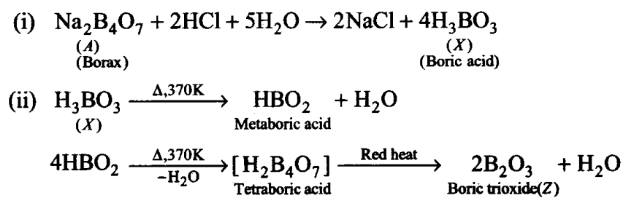
Long Answer Type
Q1. Describe the general trends in the following properties of the elements in Groups 13 and 14.
(i) Atomic size
(ii) Ionisation enthalpy
(iii) Metallic character
(iv) Oxidation states
(v) Nature of halides
Answer: For Group 13
(i) Atomic Size On moving down the group for each successive member, one extra shell of electrons is added and therefore, atomic radius is expected to increase. However, a deviation can be seen.
Atomic radius of \(\mathrm{Ga}\) is less than that of \(\mathrm{Al}\) due to presence of additional 10\(d\) – electrons, which offer poor screening effect to the outer electron.
(ii) Ionisation Enthalpy The ionisation enthalpy values as expected from general trends do not decrease smoothly down the group. The decrease from \(\mathrm{B}\) to \(\mathrm{Al}\) is associated with increase in size.
The observed discontinued between \(\mathrm{Al}\) and \(\mathrm{Ga}\) and between In and TI due to low screening effect of \(d\) and \(f\)-electrons which compensates increased nuclear charge.
(iii) Metallic or Electropositive Character Boron is a semi-metal (metalloid) due to very high ionisation enthalpy. All others are metals and metallic character first increases from \(\mathrm{B}\) to \(\mathrm{Al}\) as size increases. From \(\mathrm{Al}\) to \(\mathrm{Tl}\) decrease due to poor shielding of \(d\) – and \(f\)-electrons.
(iv) Oxidation States As we move down the group, the stability of +3 oxidation state decreases while that of +1 oxidation state progressively increases. In other words, the order of stability of +1 oxidation state increase in the order. \(\mathrm{Al}<\mathrm{Ga}<\mathrm{In}<\mathrm{Tl}\). Infact, in Ga, In and Tl, both +1 and +3 oxidation states are observed.
(v) Nature of Halides These elements react with halogens to form trihalids (except \(\mathrm{TlI}_3\) )
\(
2 E(s)+3 X_2(g) \longrightarrow 2 \mathrm{EX}_3(s) \quad[X=\mathrm{F}, \mathrm{Cl}, \mathrm{Br}, \mathrm{I}]
\)
Boron in halides are electron deficient molecules and behave as Lewis acids. The Lewis character decreases in the order: \(\mathrm{BI}_3>\mathrm{BBr}_3>\mathrm{BCl}_3>\mathrm{BF}_3\)
For Group 14
(i) Atomic Size There is considerable increase in covalent radius from C to Si thereafter from Si to Pb as small increase in radius is observed. This is due to the presence of completely filled \(d\) and \(f\)-orbitals in heavier member.
(ii) Ionisation Enthalpy The first ionisation enthalpy of group 14 members is higher than the corresponding members of group 13. The influence of inner core electrons is visible here. In general the ionisation enthalpy decreases down the group. Small decrease in \(
\Delta_i \mathrm{H}\) from Si to Ge to Sn and slight increase in \(\Delta_i \mathrm{H}\) from Sn to Pb is the consequence of poor shielding effect of intervening \(d\) and \(f\)-orbitals and increase in size of the atom.
(iii) Metallic Character Metallic character increases down the group C (non-metal) Si, Ge (metalloid) \(\mathrm{Sn}, \mathrm{Pb}\) (metals).
(iv) Oxidation States The group 14 elements have four electrons in the outermost shell. The common oxidation states exhibited by these elements are +4 and +2 . Carbon also exhibits negative oxidation states. Since, the sum of the first four ionisation enthalpies is very high, compounds in +4 oxidation states are generally covalent in nature. In heavier members the tendency to show +2 oxidation state increases in the \(\mathrm{Ge}<\mathrm{Sn}<\mathrm{Pd}\) due to inert pair effect.
(v) Nature of Halides These elements can form halides of formula \(M X_2\) and \(M X_4\) (where, \(X=\mathrm{F}, \mathrm{Cl}, \mathrm{Br}, \mathrm{I}\) ). Except carbon, all other members react directly with halogen under suitable condition to make halides.
Most of \(M X_4\) are covalent with \(s p^3\) hybridisation and tetrahedral in structure. Exceptions are \(\mathrm{SnF}_4\) and \(\mathrm{PbF}_4\) which are ionic in nature. Heavier members Ge to Pb are able to make halides of formula \(M X_2\). Stability of halides increases down the group.
Q2. Account for the following observations:
(i) \(\mathrm{AlCl}_3\) is a Lewis acid
(ii) Though fluorine is more electronegative than chlorine yet \(\mathrm{BF}_3\) is a weaker Lewis acid than \(\mathrm{BCl}_3\)
(iii) \(\mathrm{PbO}_2\) is a stronger oxidising agent than \(\mathrm{SnO}_2\)
(iv) The +1 oxidation state of thallium is more stable than its +3 state.
Answer: (i) In \(\mathrm{AlCl}_3, \mathrm{Al}\) has only six electrons in its valence shell. It is an electron deficient species. Therefore, it acts as a Lewis acid (electron acceptor).
(ii) In \(\mathrm{BF}_3\) boron has a vacant \(2 p\)-orbital and fluorine has one \(2 p\)-completely filled unutilised orbital. Both of these orbitals belong to same energy level therefore, they can overlap effectively and form \(p \pi-p \pi\) bond. This type of bond formation is known as back bonding.
While back bonding is not possible in \(\mathrm{BCl}_3\), because there is no effective overlapping between the \(2 p\)-orbital of boron and \(3 p\)-orbital of chlorine. Therefore, electron deficiency of B is higher in \(\mathrm{BCl}_3\) than that of \(\mathrm{BF}_3\). That’s why \(\mathrm{BF}_3\) is a weaker Lewis acid than \(\mathrm{BCl}_3\).
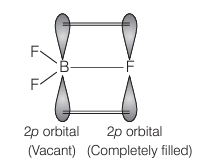
(iii) In \(\mathrm{PbO}_2\) and \(\mathrm{SnO}_2\), both lead and tin are present in +4 oxidation state. But due to stronger inert pair effect, \(\mathrm{Pb}^{2+}\) ion is more stable than \(\mathrm{Sn}^{2+}\) ion. In other words, \(\mathrm{Pb}^{4+}\) ions i.e., \(\mathrm{PbO}_4\) is more easily reduced to \(\mathrm{Pb}^{2+}\) ions than \(\mathrm{Sn}^{4+}\) ions reduced to \(\mathrm{Sn}^{2+}\) ions. Thus, \(\mathrm{PbO}_2\) acts as a stronger oxidising agent than \(\mathrm{SnO}_2\).
(iv) \(\mathrm{Tl}^{+}\)is more stable than \(\mathrm{Tl}^{3+}\) because of inert pair effect.
Q3. \(\mathrm{BCl}_3\) exists as monomer whereas \(\mathrm{AlCl}_3\) is dimerised through halogen bridging. Give reason. Explain the structure of the dimer of \(\mathrm{AlCl}_3\) also.
Answer: Boron halides do not exist as dimer due to small size of boron atom which makes it unable to accommodate four large sized halide ions. \(\mathrm{AlCl}_3\) exists as dimer. \(\mathrm{Al}\) makes use of vacant \(3 p\)-orbital by coordinate bond i.e., \(\mathrm{Al}\) atoms complete their octet by forming dimers.
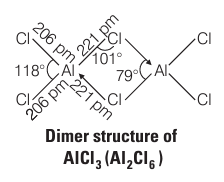
Q4. Boron fluoride exists as \(\mathrm{BF}_3\) but boron hydride doesn’t exist as \(\mathrm{BH}_3\). Give reason. In which form does it exist? Explain its structure.
Answer: Due to \(p \pi-p \pi\) back bonding, the lone pair of electrons of \(F\) is donated to the \(B\)-atom. This delocalisation reduces the deficiency of electrons on B thereby increasing the stability of \(\mathrm{BF}_3\) molecule.
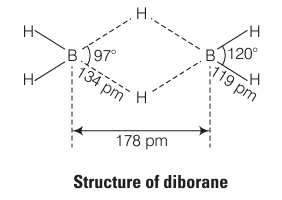
Due to absence of lone pair of electrons on H -atom, this compensation does not occur in \(\mathrm{BH}_3\). In other words, electron deficiency of B stays and hence to reduce its electron deficiency, \(\mathrm{BH}_3\) dimerises to form \(\mathrm{B}_2 \mathrm{H}_6\).
In \(\mathrm{B}_2 \mathrm{H}_6\), four terminal hydrogen atoms and two boron atoms lie in one plane. Above and below this plane there are two bridging H -atoms. The four terminal \(\mathrm{B}-\mathrm{H}\) bonds are regular while the two bridge \((\mathrm{B}-\mathrm{H}-\mathrm{B})\) bonds are three centre- two electron bonds.